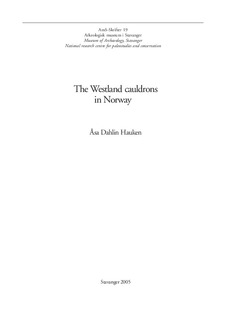The Westland cauldrons in Norway
Book
Permanent lenke
http://hdl.handle.net/11250/181439Utgivelsesdato
2005Metadata
Vis full innførselSamlinger
- AmS-Skrifter [10]
Originalversjon
Hauken, Å.D. (2005) The Westland cauldrons in Norway. Stavanger : Arkeologisk museum i StavangerSammendrag
The Westland cauldrons constitute the largest group of so called Roman imports in Norway. 112 cauldrons
are recorded, of these 110 are found in graves. This work gives an exhaustive presentation of all the known
finds with Westland cauldrons in Norway. A new classification of the cauldrons is made, based on an analysis
of the cauldron’s profile. The cauldrons are divided into two classes, 1 and 2, each subdivided into types. The
chronology of the cauldrons is investigated within an already existing framework, showing that the new
classification also is chronologically relevant. Type 2C cauldrons cover the Late Roman Iron Age (C3) and
the Migration Period, whereas class 1 cauldrons are found only in the C3, and type 2D cauldrons only in the
late Migration Period. Different production techniques are discussed in detail. Class 1 cauldrons are hammered,
class 2 cauldrons are both hammered and treated on a lathe. Based on the metalworking techniques
a local, Norwegian production is rejected. The significance of Westland cauldrons in the West Norweigan
society is discussed. A comparison between the graves containing cauldrons and a contemporary group of
graves showed that there is a qualitative, but not a quantitative difference between the groups. There is also
a fluctuation in wealth through time in both groups. The cauldrons served as status markers amongst the
living. As gravegoods they could serve to further enhance the reputation of the deceased and the family. The
fluctuation in the wealth of the graves is interpreted as an in- or decreasing need for social competition in an
inherently unstable society. Finally the mode of exchange is discussed, pointing to the importance of gift
exchange, both as a means of acquiring high status goods, creating a retinue and forming alliances, but also
as a means to facilitate the exchange of more mundane necessity products.
Beskrivelse
Text is © Arkeologisk museum i Stavanger; some photos are © Kulturhistorisk museum in Oslo.
